

Ciencia y Deporte. Vol. 9. No. 3, September -December, 2024, p.e268.
Original article
The promotion of physical activity through infographics issued by governments in Latin America
La promoción de la activación física mediante infografías emitidas por gobiernos latinoamericanos
A promoção da ativação física por meio de infográficos emitidos por governos na América Latina
1Benemérita Autonomous University of Puebla, Faculty of Communication Sciences. Puebla, Mexico.
*Corresponding author: columbie.tkd@gmail.com
Received: 29/05/2024
Accepted: 09/08/2024
ABSTRACT
Introduction: The lack of physical activity is a condition that affects 40% of adults worldwide.
In some Latin American countries, this rate is close to 50 %.
Objective: To characterize the promotion of physical activity through infographics issued by
Latin American governments with the highest rates of inactivity, in the years 2020 and 2024.
Methods: Descriptive, retrospective, non-experimental, and cross-sectional design. An
instrument consisting of 72 items, previously validated by 10 judges, was used to analyze 61
infographics issued by eight Latin American countries with the lowest levels of Physical Activity (PA).
Results: The infographics have a balanced structure between images and text. They utilize
visual resources that are accessible to the audience. Although the messages expressed are aimed
at motivating the population and raising awareness of the benefits of PA, there is a tendency
toward persecutory health in the content of the message.
Conclusions: Analyzing the communication materials issued by governments allows for
the construction of more effective messages in promoting the health of various sectors within
the community.
Keywords: physical activity, infographic, health communication, motivation, Latin American governments.
RESUMEN
Introducción: la falta de activación física, es un estado que prevalece en 40 % de los adultos del
mundo. En el caso de algunos países de América Latina, este índice es cercano al 50 %.
Objetivo: caracterizar la promoción de la actividad física mediante infográficos que emiten los
gobiernos latinoamericanos con mayor índice de inactividad, 2020 y 2024.
materiales y métodos: diseño descriptivo, retrospectivo, no experimental y transversal. Se utilizó un
instrumento de 72 ítems, previamente validado por diez jueces; que permitió observar a 61 infografías emitidas
por ocho países latinoamericanos con menor índice de Activación Física.
Resultados: las infografías tienen una estructura balanceada entre imagen y texto. Utilizan
recursos visuales asequibles para quien los consulta. Los mensajes que se plasman, aunque se dirigen a
motivar a la población y dar a conocer los beneficios de la AF, se deja ver una tendencia por la salud
persecutoria en el contenido del mensaje.
Conclusiones: analizar las piezas comunicativas que los gobiernos emiten, permite construir
mensajes más efectivos en la promoción de la salud de los distintos sectores que integran a la
comunidad.
Palabras clave: activación física, infografía, comunicación para la salud, motivación, gobiernos latinoamericanos.
RESUMO
Introdução: a falta de ativação física é um estado que prevalece em 40% dos adultos no mundo. No caso de alguns países latino-americanos, esta taxa está próxima de 50%.
Objetivo: caracterizar a promoção da atividade física por meio de infográficos emitidos pelos governos latino-americanos com maior taxa de inatividade, 2020 e 2024.
Métodos: Desenho descritivo, retrospectivo, não experimental e transversal. Foi utilizado um instrumento de 72 itens, previamente validado por 10 juízes; o que nos permitiu observar 61 infográficos emitidos por 8 países da América Latina com menor índice de Ativação Física.
Resultados: Os infográficos possuem uma estrutura equilibrada entre imagem e texto. Utilizam recursos visuais acessíveis a quem os consulta. Nas mensagens expressas, embora visem motivar a população e dar a conhecer os benefícios da AF, verifica-se no conteúdo da mensagem uma tendência para a saúde persecutória.
Conclusões: A análise das peças de comunicação que os governos emitem permite-nos construir mensagens mais eficazes na promoção da saúde nos diferentes sectores que compõem a comunidade.
Palavras-chave: ativação física, infográficos, comunicação em saúde, motivação, governos latino-americanos.
INTRODUCTION
According to the World Health Organization (WHO) (2021), low or no Physical Activity (PA) is the fourth risk factor for mortality worldwide, accounting for 6% of deaths at this level; this percentage exceeds other conditions such as hypertension, high blood glucose, or high tobacco consumption. It is also considered the primary cause of 1 in 4 cases of breast and colon cancers, 27% of diabetes cases, and 3 out of 10 ischemic heart diseases. Additionally, it has a direct relationship with obesity levels in both children and adults. Its incidence is such that, by the second decade of the 21st century, the WHO had already allocated economic resources and proposed 20 regulatory measures aimed at reducing physical inactivity by 30% by 2030 (WHO, 2019).
Physical activity is understood as bodily movement resulting from the functionality of skeletal muscles, which involves energy expenditure by the individual. Although this definition encompasses a wide variety of movements, PA is characterized by being structured and repetitive; its purpose is not competition (Perea-Caballero et al., 2020) but rather recreation (Luarte Rocha et al., 2016; Monroy, Antón et al., 2018). Thus, PA has been conceived as a practice that, when performed systematically and regularly, has significant benefits for physical (Gómez Figueroa, 2009) and mental health (Calpa-Pastas et al., 2019; Peñarrubia-Lozano et al., 2021) across various age groups and individuals with different abilities (Muñoz Hinrichsen and Martínez Aros, 2022) or conditions (Valdez Méndez, 2015).
Given that sedentarism is a public health problem (Ladino Marín and Prada Penagos, 2024), PA has gained relevance for national governments, which must ensure that their governed population has the necessary conditions for a better quality of life. At the same time, these entities must take concrete actions in response to the consequences of a lack of PA, such as increasing free health services or medical campaigns addressing diseases stemming from low levels of PA (García-Tascón et al., 2021).
Therefore, it is essential for governments to disseminate appropriate information so that the community understands PA and its impact on daily life and health status (Nogueira et al., 2021). To achieve this, health promotion campaigns should utilize communication supports that can be accessed in public places and digital spaces. Furthermore, these resources must integrate specific data to educate those who consult them, ensuring that the messages used are comprehensible to any citizen, regardless of their literacy level (Hernández-Fernández and Morera-Vidal, 2022). One resource that meets these requirements is the infographic; being a visual tool that provides information in less than 5 seconds, it becomes very appealing to viewers. Thus, in recent years, many national governments have incorporated infographics as part of their efforts to reach their populations with information. An example of this was their extensive use during the recent pandemic (Castillo-Esparcia et al., 2020).
Considering the aforementioned background, the general objective of this research was to characterize the promotion of physical activity through infographics issued by Latin American governments with the highest rates of inactivity from 2020 to 2024. The specific objectives included: a) Describing the messages issued for promoting physical activity by Latin American governments; b) Delimiting the elements included in the structure of the observed infographics that promote physical activity.
MATERIALS AND METHODS
The research was conducted using a descriptive, non-experimental, and retrospective design, considering that communicative pieces published between 2020 and 2023 were reviewed; this led to a mere characterization of these visual resources in digital format included in the sampling. It was a cross-sectional cohort study, as data were collected at a single point in time during the month of May 2024. The variables of interest were the structure of the infographic and the message about physical activity.
A non-probabilistic snowball sampling method was implemented, as infographics were located on the official electronic sites such as websites or social media of the mentioned governments. Thus, 59 infographics published by Latin American governments with the lowest levels of physical activity, according to WHO Medical Edition, 2022, were retrieved. The concentration of observed pieces is shown in Table 1.
Table 1. - Number of infographics retrieved
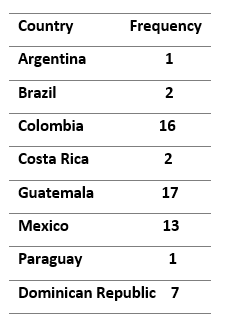
The content analysis was used as a quantitative technique, and the data collection was based on a previously validated observation guide by a panel of 10 experts through the Lawshe Validity Index; the items that were retained obtained a Content Validity Ratio (CVR) of .62. After this validation process, the instrument consisted of 72 items. The observation involved identifying the presence of the items corresponding to the variables and sub-variables of interest relevant to this research. The data collected during this process underwent descriptive statistical treatment using the SPSS program, in order to present the results through graphs and tables.
RESULTS AND DISCUSSION
Six out of ten observed units were located on the official Facebook pages of the countries included in the study. Mexico, Guatemala, and the Dominican Republic are the governments that use these spaces to disseminate this type of resource; and in the case of Mexico and Guatemala, they utilize other digital social networks such as Instagram and X (formerly Twitter). Meanwhile, Brazil, Colombia, and Costa Rica only publish their materials through their governmental websites. This information dissemination strategy implemented by these governments is limited, given that currently, many citizens obtain information through virtual collaborative spaces (Benaissa Pedriza, 2018; Espinoza-Portilla and Mazuelos-Cardoza, 2020). Furthermore, 95 % of the infographics are published by one of the ministries or secretariats that make up the governmental structures of each country; the rest credit the national government as the autho rMexico, with two units, and Argentina, with one unit.
Figure 1 clearly shows that Guatemala is the country that publishes the most pieces; it is also noteworthy that in 2023 and 2021, there was more dissemination of this type of visual content. It is important to emphasize that there is no periodicity in the publication of these communicative pieces, which is a way to strengthen the attention and follow-up of the issues of the citizens who consume this type of information resource, (Universitat Oberta de Catalunya, n.d.) (Figure 1).
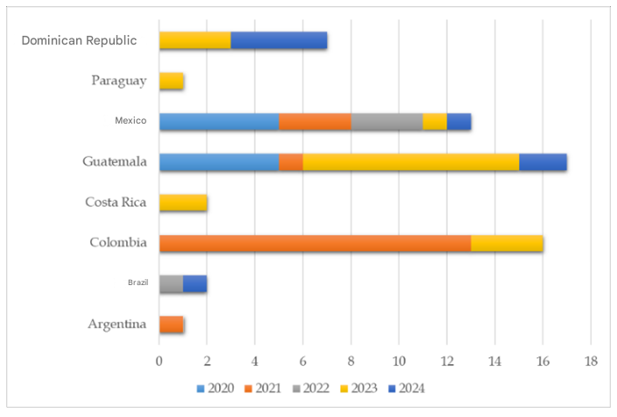
Fig. 1. - Infographic Publication Concentration by Year and Country
As part of the study's objectives, the structure of the infographics included was observed. Figure 2 summarizes the characteristics identified in the infographics. All pieces include a title; 92 % are organized by specific information units to address a topic, and 85 % include illustrations. The use of hyperlinks or subtitles is less commonaround 28 %. Additionally, to contextualize the infographic, 48 % of the visual pieces include topic-related tags. The most used tags also known as hashtagsare #ActivacionFisica, #cuituraGUATE, #CadaMinutoCuenta, #CadaPasoCuenta, and #JuevesdeNutricion. Mexico and Guatemala are the countries that use the most tags. In this regard, it is necessary for information managers to integrate more digital elements that allow those who consult these types of visual resources to delve deeper into the topics presented, increasing the possibility of raising awareness about PA and avoiding infodemics (WHO, 2020) (Figure 2).
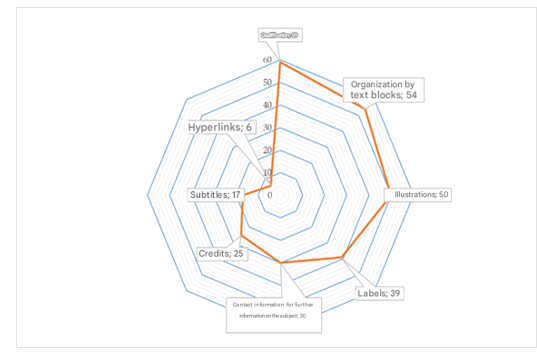
Fig. 2. - Elements Identified in the Infographic Structure
Regarding the type of message conveyed by the infographics, 73 % were informative; the rest were persuasive. Additionally, regarding message content, there is a tendency to promote PA as a means of health preservation and disease prevention8 out of 10 observed pieces. This informative approach seems appropriate, considering that, the analyzed countries have high levels of sedentary behavior, and lack of PA can constitute a public health problem (Ladino Marín and Prada Penagos, 2024). Therefore, the messages about PA that are communicated should really make the individual aware of the seriousness that a passive lifestyle has for his or her life in the short, medium and long term. In contrast, countries like Paraguay and Argentina use infographics to showcase physical spaces for regular PAone infographic per country showing the bike lanes, cycling routes, and park modifications and creations that governments have implemented for public use (de la Peña-de León et al., 2017; Castillo-Retamal et al., 2020). Moreno-Manzo and Navarro-Chávez (2020) point out that these types of messages are relevant for positioning the governmental administration that publishes them, as they highlight work done for their electorate. However, they will only benefit PA levels if citizens understand that the message aims to inform them about spaces they can use for physical activity; otherwise, it might be seen merely as state-sponsored positioning.
Concerning the content of the infographics regarding recommendations for PA, 7 out of 10 pieces mention general recommendations on the frequency, intensity, and duration of exercise, according to international organizations. In contrast, only one piece emphasizes the need to consult a professional to diagnose the health status of someone interested in starting vigorous exercise these results are shown in Table 2. This is noteworthy, as the WHO (2019, 2021) itself not only mentions PA as an option for physical activity but considers it a more integral process where nutrition and medical assistance are crucial for optimizing the benefits of PA. Therefore, a series of infographics should be developed that inform about all the important aspects to consider for achieving correct PA.
Table 2. - Physical Activity (PA) Execution
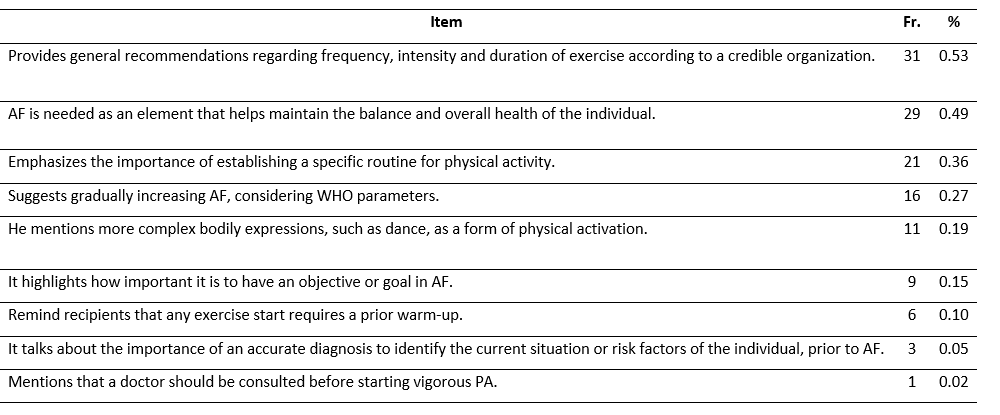
Another important element to consider regarding PA practice is the extrinsic motivation individuals receive to perform this action. Table 3. shows that 88% of the analyzed communication pieces send messages targeted at specific age groups to engage in PA, as proposed by Perea-Caballero et al. (2020). Furthermore, there is a tendency to encourage those who consult the infographics to approach PAaround 82%. However, the wording of the content in these visual supports does not consider inclusive language at all, despite some pieces targeting the general audience (Cala and Navarro, 2011); this currently represents an area for improvement. Similarly, governmental entities need to send messages that counteract the emotional barriers some members of society have regarding PA (Tavarnier Morga et al., 2021; World Health Organization, 2022; Quintana Escurra, 2023) (Table 3).
Table 3. - Motivation towards Physical Activity (PA)
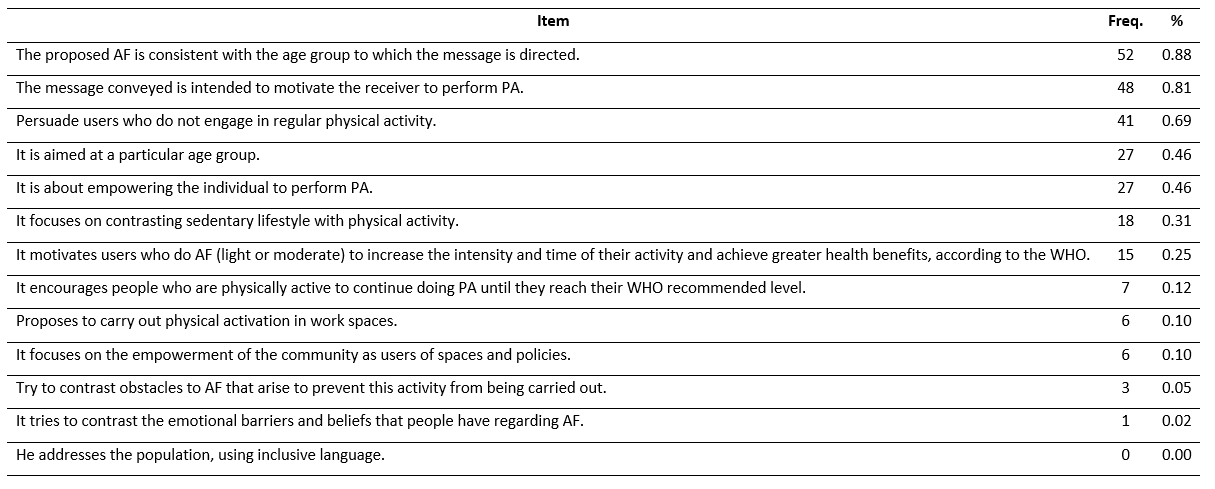
Table 4 shows that 78% of the infographics included in this study highlight how PA contributes to healthy lifestyles with 53 % of the pieces specifically addressing this (Calpa-Pastas et al., 2019; Peñarrubia-Lozano et al., 2021). However, a notable deficiency is the lack of promotion regarding the impact of PA on people with disabilities, as suggested by Muñoz Hinrichsen and Martínez Aros (2022), or on individuals seeking to reduce harmful substance use, as noted by Valdez Méndez (2015) (Table 4).
Table 4. - Benefits and Impact of Physical Activity (PA)
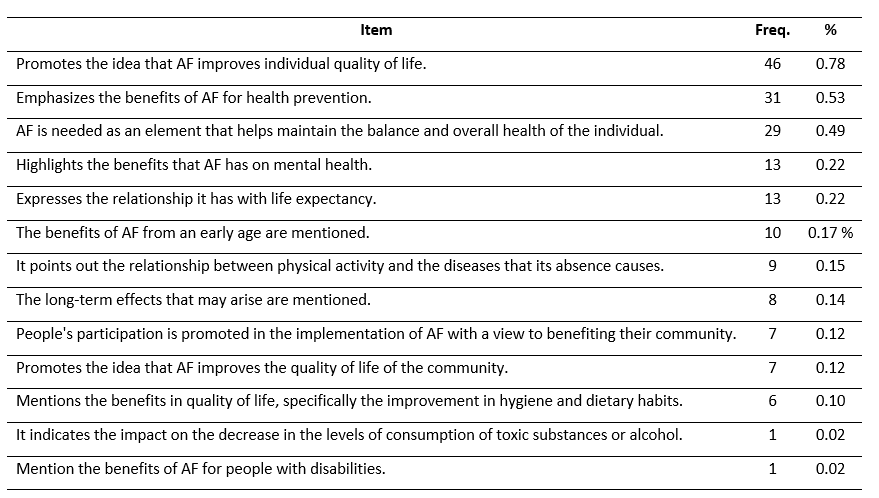
Regarding the government and the community as promoters of PA, in the design of the messages, the persecutory health tone predominates in two out of ten pieces, in which the individual is pointed out as the main responsible for his or her inactivity (Meinardi, 2021). This is combined with the use of imperative phrases to incentivize citizens to engage in PA. Conversely, only one infographic shows the sender (government) addressing the social and economic conditions that limit opportunities for PAsee Table 5 for details. Therefore, the content of communication pieces should be oriented towards a more responsible approach with citizens (De La Guardia Gutiérrez and Ruvalcaba Ledezma, 2020), as the state has an obligation to provide the necessary safety conditions for individual well-being (Rodríguez-Blanco, 2021). This includes health and recreation infrastructure, as well as engaging other entities in promoting PA, such as businesses (Gómez-Chacón et al., 2018) and educational institutions.
Table 5. - Government and Community in Physical Activity (PA)
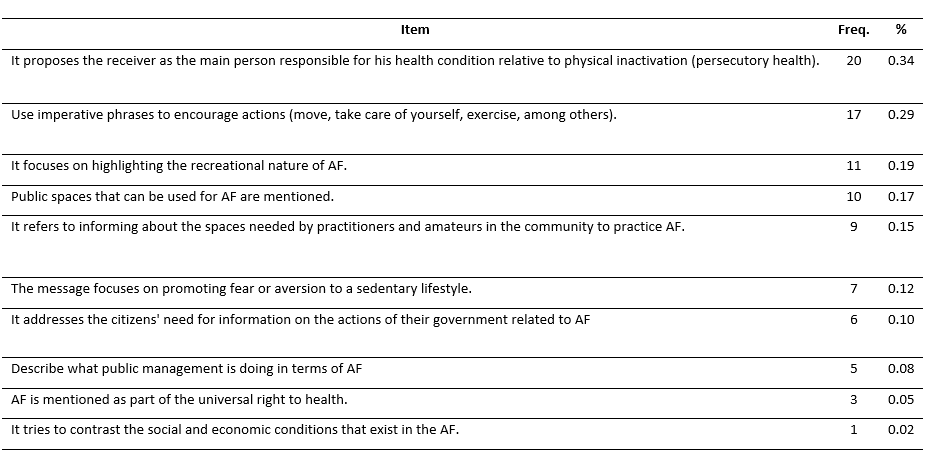
CONCLUSIONS
This paper analyzed the messages issued for the promotion of PA by national entities. Infographics were found to provide recommendations on how to be active, reduce disease risk, and improve quality of life. Although an informative tone is used to motivate citizens towards activity, a tendency towards a persecutory health approach was identified, based on the type of sentences and verbs used in the infographic text. This overlooks health as a universal right and the state's responsibility to provide the resources needed to meet community health needs. Thus, the objective of this work has been addressed.
Regarding objective "b", infographics were found to be an accessible source of information on PA, although not widely used by the governments studied. Titles, images, and organized data blocks enhance comprehension. However, some elements for improved infographic dissemination were identified, specifically the inclusion of hyperlinks to information from reputable organizations addressing PA, enabling safer and more informed citizen engagement.
This research was limited to observing digital resources published by Latin American governments and still available online. Future research should conduct a longitudinal cohort study of infographics and other communicative products digital and print used in health campaigns related to PA, for a more accurate assessment of measures implemented to counteract sedentary lifestyles.
Several areas for improvement were identified. First, infographics on PA should be disseminated in the various native languages of Latin American countries to broaden the impact of health promotion. Second, PA promotion should target minority groups, considering their specific characteristics and needs, developing functional PA adoption strategies for these sectors.
Finally, further research is needed to observe how states promote PA, aiming to provide increasingly relevant health information affecting large populations. It is also important to consider that such visual resources infographics not only inform but also help prevent harmful practices that, if unaddressed, could lead to serious health problems for the community at large.
BIBLIOGRAPHIC REFERENCES
Benaissa Pedriza, S. (2018). Las redes sociales como fuente de información periodística en la prensa digital española (El País, El Mundo, La Vanguardia y ABC). Index.comunicación, 8(3), 13-42. https://indexcomunicacion.es/index.php/indexcomunicacion/article/view/401
Cala, O. C., y Navarro, Y. B. (2011). La actividad física: un aporte para la salud. Lecturas: Educación física y deportes, 16(159), 1-11. https://www.efdeportes.com/efd159/la-actividad-fisica-para-la -salud.htm
Calpa-Pastas, A. M., Santacruz-Bolaños, G. A., Álvarez-Bravo, M., Zambrano-Guerrero, C. A., Hernández-Narváez, E. D. L., y Matabanchoy-Tulcan, S. M. (2019). Peñarrubia-Lozano, Hacia la Promoción de la Salud, 24(2), 139-155.
Castillo-Esparcia, A., Fernández-Souto, A. B., & Puentes-Rivera, I. (2020). Comunicación política y Covid-19. Estrategias del Gobierno de España. Profesional De La información, 29(4). https://doi.org/10.3145/epi.2020.jul.19
Castillo-Retamal, F., Matus-Castillo, C., Vargas-Contreras, C., Canan, F., Starepravo, F. A., y Bássoli de Oliveira, A. A. (2020). Participación ciudadana en la elaboración de las políticas públicas de actividad física y deporte: el caso de Chile. Retos: nuevas tendencias en educación física, deporte y recreación, 38, 482-489.
OMS. Edición Médica (2022). OMS revela que países latinoamericanos presentan la tasa más alta de sedentarismo. Salud Pública. https://tinyurl.com/bdze7eu9
Espinoza-Portilla, E., y Mazuelos-Cardoza, C. (2020). Desinformación sobre temas de salud en las redes sociales. Revista Cubana de Información en Ciencias de la Salud, 31(2), 1-11. https://acimed.sld.cu/index.php/acimed/article/view/1498/pdf_20
De La Guardia Gutiérrez, M. A. y Ruvalcaba Ledezma, J. C. (2020). La salud y sus determinantes, promoción de la salud y educación sanitaria. Journal of Negative and No Positive Results, 5(1), 81-90. https://dx.doi.org/10.19230/jonnpr.3215
De la Peña-de León, A., Amezcua-Núñez, J. B. y Hernández-Bonilla, A. (2017). La promoción de estilos de vida saludable aprovechando los espacios públicos. Horizonte sanitario, 16(3), 201-210. https://doi.org/10.19136/hs.a16n3.1878
García-Tascón, M., Mendaña-Cuervo, C., Sahelices-Pinto, C. Magaz-González, A. M. (2021). La Repercusión en la calidad de vida, salud y práctica de actividad física del confinamiento por Covid-19 en España. Retos: nuevas tendencias en educación física, deporte y recreación, 42, 684-695. https://tinyurl.com/y6bstynb
Gómez-Chacón, R., Morales-Sánchez, V., Hernández-Mendo, A., y Muñoz-Llerena, A. (2018). La práctica de actividad física y su relación con la satisfacción laboral en una consultora informática. SPORT TK-Revista EuroAmericana de Ciencias del Deporte, 7(2), 35-40. https://doi.org/10.6018/sportk.343081
Gómez Figueroa, J. A. (2009). Las prácticas de la actividad física en Veracruz. Educación Física y Ciencia, 11(11), 183-189. https://tinyurl.com/bp78wcz6
Hernández-Fernández, A. y Morera-Vidal, F. (2022). Infographics, a better medium than plain text for increasing knowledge. Gráfica: Journal of Graphic Design, 10(18), 23-40. https://doi.org/10.5565/rev/grafica.204
Ladino Marín, P. C. y Prada Penagos, R. (2024). Análisis del encuadramiento periodístico en tiempos de pandemia de covid-19 en los principales diarios de Colombia: El Tiempo y El Espectador. Salud Colectiva, 20, 1-12. https://doi.org/10.18294/sc.2024.4593
Luarte Rocha, C., Garrido Méndez, A., Pacheco Garrido, J., y Daolio, J. (2016). Antecedentes históricos de la Actividad Física para la salud. Revista Ciencias de la Actividad Física UCM, 17(1), 67-76. https://revistacaf.ucm.cl/article/view/92
Meinardi, E. (2021). Educación en salud colectiva: un diálogo de saberes. Revista de Educación en Biología, 24(1), 415. https://doi.org/10.59524/2344-9225.v24.n1.31971
Monroy Antón, A., Calero Morales, S., y Fernández Concepción, R. (2018). Los programas de actividad física para combatir la obesidad y el sobrepeso en adolescentes. Revista Cubana de Pediatría, 90(3), 1-9. https://revpediatria.sld.cu/index.php/ped/article/view/393/221
Moreno-Manzo, J. M. y Navarro-Chávez, J. C. L. (2020). Factores determinantes de la reputación gubernamental: una ponderación a través del algoritmo de Saaty. Ciencia Ergo-sum, 27(1), e71, 1-14. https://doi.org/10.30878/ces.v27n1a3
Muñoz Hinrichsen, F., y Martínez Aros, A. (2022). Actividad física adaptada en el proceso de rehabilitación de personas con discapacidad: una propuesta desde la perspectiva social. Pensar En Movimiento: Revista de Ciencias del Ejercicio y la Salud, 20(1), 1-11. https://doi.org/10.15517/pensarmov.v20i1.47007
Nogueira, J., Gonçalves Rocha, D. y Akerman, M. (2021). Políticas públicas adoptadas en la pandemia de la COVID-19 en tres países de América Latina: contribuciones de la Promoción de la Salud para no volver al mundo que existía. Global Health Promotion, 28(1), 117-126. https://doi.org/10.1177/1757975920977837
Organización Mundial de la Salud. (2019). Plan de acción mundial sobre actividad física 2018-2030. Personas más activas para un mundo más sano. https://tinyurl.com/486mxpb8
Organización Mundial de la Salud. (2020). Aplanemos la curva de la infodemia. https://www.who.int/es/news-room/spotlight/let-s-flatten-the-infodemic-curve
Organización Mundial de la Salud. (2021). Directrices de la OMS Sobre Actividad Física y Comportamientos Sedentarios.https://tinyurl.com/354vr8b3
Paredes Prada, E. T., Pérez Casanova, M. F., y Lima Rodrigues, J. A. (2020). Actividad física en adultos: recomendaciones, determinantes y medición. Revista Habanera de Ciencias Médicas, 19(4), 1-16. http://www.revhabanera.sld.cu/index.php/rhab/article/view/2906
Peñarrubia-Lozano, C., Romero-Roso, L., Olóriz-Nivela, M., y Lizalde-Gil, M. (2021). El desafío como estrategia para la promoción de actividad física en universitarios. Retos, 39, 58-64. https://zaguan.unizar.es/record/95740?ln=es#:~:text=10.47197/retos.v0i39.78228
Perea-Caballero, A. L., López-Navarrete, G. E., Perea-Martínez, A., Reyes-Gómez, U., Santiago-Lagunes, L. M., Ríos-Gallardo, P. A., ... y De la Paz-Morales, C. (2020). Importancia de la actividad física. Salud Jalisco, 6(2), 121-125. https://www.medigraphic.com/pdfs/saljalisco/sj-2019/sj192h.pdf
Quintana Escurra, C. E. (2023). Actividad Física y Sedentarismo en Jóvenes Universitarios de la Ciudad de Pilar. Ciencia Latina Revista Científica Multidisciplinar, 7(4), 8212-8231. https://doi.org/10.37811/cl_rcm.v7i4.7557
Rodríguez-Blanco, V. (2021). ¿Se vulneró el Derecho a recibir información durante el primer estado de alarma en la crisis del COVID-19? Revista Española de la Transparencia, 12, 227-246. https://doi.org/10.51915/ret.136
Valdez Méndez, S. F. (2015). Fomento de la actividad física en México. Una política pública inacabada. Gestión y Política Pública, Volumen temático 2015, 27-54. https://doi.org/10.29265/gypp.v0i0.118
World Health Organization. (2022). Global status report on physical activity 2022. World Health Organization.
Conflict of interest statement:
The authors declare having competing interests.
Author contribution statement:
The authors have participated in the redaction of the manuscript and the documentary review.
![]()
This paper is distributed under the terms of the Licencia CreativeCommons (CC) 4.0. (CC BY-NC-SA 4.0)
Copyright (c) 2024
Paola Eunice Rivera Salas